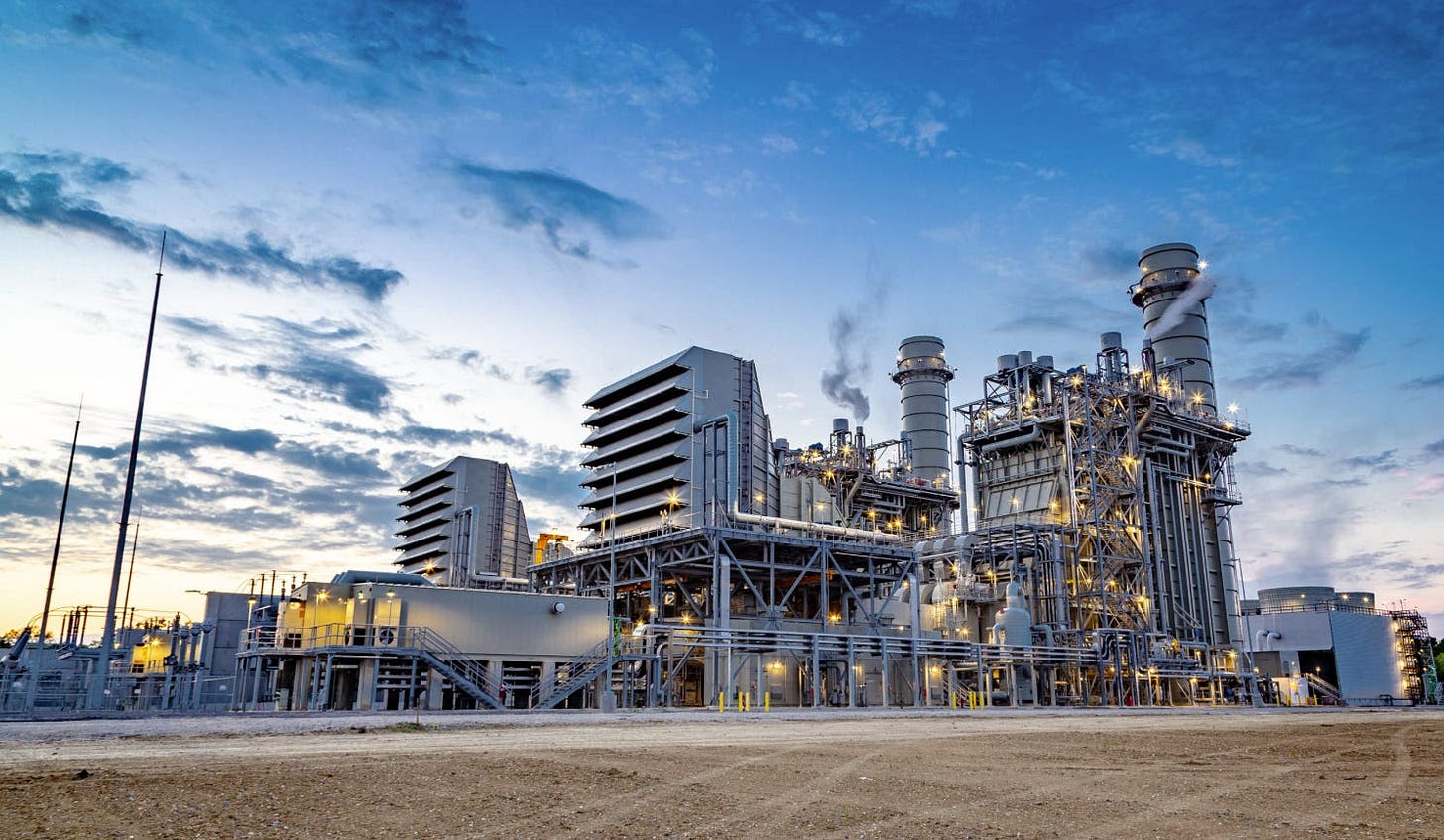“For AI and Data Centers, the Near Future Belongs to Natural Gas” By DAVID BLACKMON
“Writing at the Epoch Times, former EnCana President Gwyn Morgan lays out some of the many problems and roadblocks on the path to a renaissance in nuclear energy in the US and North America…”
For AI and Data Centers, the Near Future Belongs to Natural Gas
DEC 16
∙
PAID
A modern natural gas power plant operated by Entergy.
Writing at the Epoch Times, former EnCana President Gwyn Morganlays out some of the many problems and roadblocks on the path to a renaissance in nuclear energy in the US and North America envisioned by many.
Here are some of the points Morgan makes in his story:
Nuclear power’s limitations are rooted in its costs, risks, and delays. Even under ideal circumstances, building or restarting a nuclear facility is arduous. Consider Microsoft’s much-publicized plan to restart the long-dormant Unit 1 reactor at Three Mile Island in Pennsylvania. This project is lauded as proof of an incipient “nuclear revival,” but despite leveraging existing infrastructure it will cost US$1.6 billion and take four years to bring online.
…
The new generation of small modular reactors (SMRs), often touted as a game-changer, is still largely theoretical. In Canada—Alberta in particular—discussions around SMRs have been ongoing for years, with no concrete progress. The most optimistic projections estimate the first SMR in Western Canada might be operational by 2034.
…
The reality is that nuclear energy cannot scale quickly enough to meet urgent electricity needs. Canada’s power grid is already strained, and electricity demand is set to grow significantly, driven by electric vehicles and enormous data centres for AI applications. Nuclear power, even if expanded aggressively, cannot fill the gap within the necessary time frames.
[End]
Morgan asserts that, as a result of these and other roadblocks - like long permitting lead times - the foreseeable future for North American baseload power generation growth will belong to natural gas, not nuclear.
He isn’t wrong.
You don’t need to believe me or Morgan on that - just take a look at the plans being made by both ExxonMobil and Chevron to jump into the power generation space specific to the rapid growth of AI and data centers.
In its end-of-year financial plan presentation last week, ExxonMobil detailed plans to build a massive natural gas power plant that would supply electricity directly to data centers. The company has already secured the land for the project and is negotiating with potential customers to enter into power purchase agreements.
One of the project’s major selling points to customers is that it believes it will be able to capture 90% of the plant’s carbon emissions via a carbon capture and storage project sited adjacent to the power plant. Another selling point is that the plant would be operated independently from the power grid, thus avoiding most permitting delays and enabling it to go live in a matter of just a few years. The latter factor is a huge consideration for the Big Tech firms who have entered into power provision deals with nuclear facilities knowing that permitting delays will mean they are 10-15 years out into the future at best.
“We’re being driven by the market demand here,” Dan Ammann, who leads the company’s low-carbon business, said in an interview with The New York Times. “It’s low carbon, it’s available on an accelerated timeline and it avoids all the grid interconnection challenges.”
Chevron is also exploring opportunities in this area. Mike Wirth, that company’s chief executive, said last week that he expected power projects that did not connect to the electric grid would become more common.
Chevron CEO Mike Wirth told an event hosted by the Atlantic Council last week that his company is also exploring similar opportunities in this space. “We’re doing some work right now with a number of different people that’s not quite ready for prime time,” Mr. Wirth said.
Wirth’s remarks were echoed and expanded upon by Jeff Gustavson, president of Chevron New Energies, at the Reuters NEXT conference in New York. "We are working on this as well," Gustavson said, adding that Chevron's experience supplying natural gas around the world, and operating natural gas fired power equipment, positions the company well to meet booming electricity demand from data centers, as reported by Reuters.
"It fits many of our capabilities - natural gas, construction, operations, and being able to provide customers with a low-carbon pathway on power through CCUS (carbon capture, utilization and storage), geothermal, and maybe some other technologies," Gustavson added.
So, when you see companies like Microsoft, Google, Amazon, Meta and others boasting that their data centers will be powered by zero emission Nuclear power facilities, know that those are speculative announcements often based on technology that does not currently exist and assumptions about how long government permitting processes will take to complete. If it’s only 10-15 years out into the future, that would represent a happy outcome for those companies.
In the meantime, their data centers will still need a reliable, affordable supply 24/7, 365 day a year power generation. These companies with billions, perhaps trillions, of dollars at stake know they simply cannot depend on wind, solar, and batteries provide that to them. Thus, their most viable near-term option will be to get their power from companies who are able to build and operate natural gas power plants.
No company has the on-staff expertise needed to fill that demand in a timely manner like ExxonMobil and Chevron.
And now you know the rrrrrrrrrrrrest of the story.
That is all.




